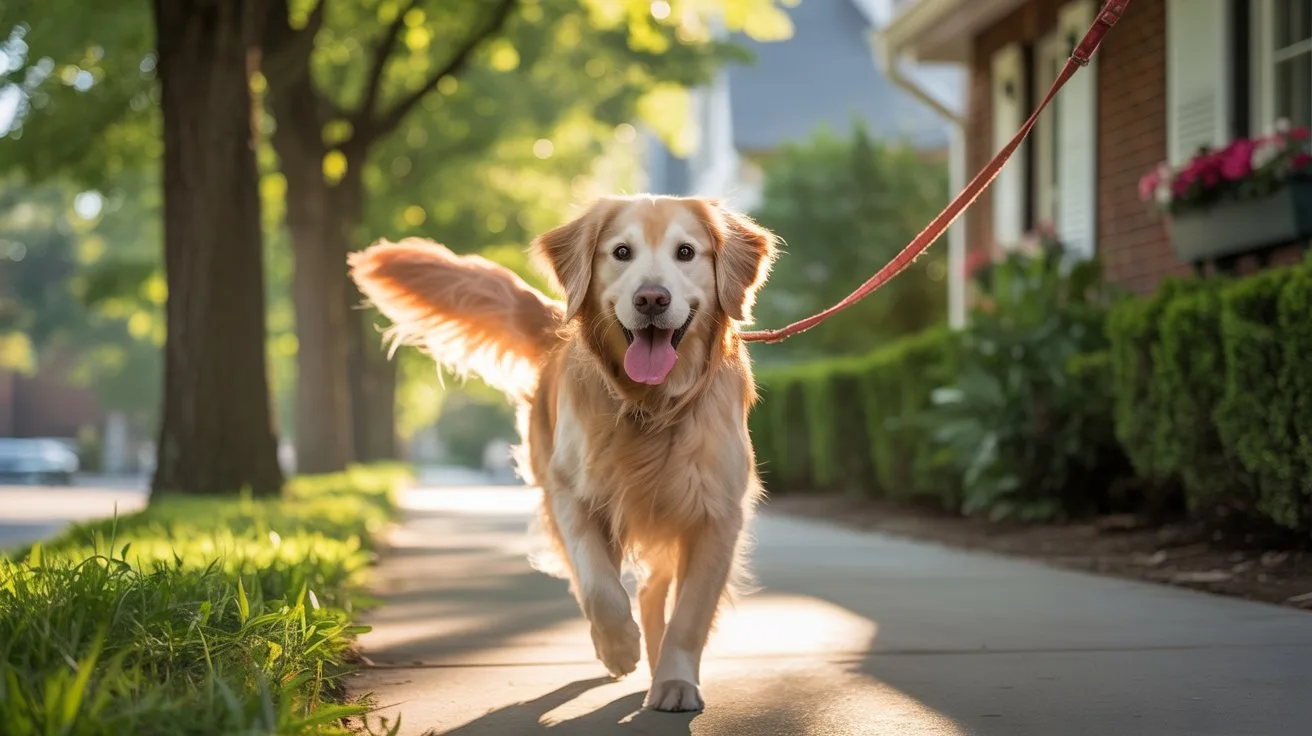You’ve seen it happen. The gentle tug toward one street instead of another. The determined pivot at the corner.
The hopeful glance toward the path less traveled by their human, but deeply treasured by them. Your dog’s preferred walking route isn’t random – it’s a deeply personal choice shaped by a complex blend of sensory experiences, emotional memories, and even their love for you.
When you follow their lead, you’re not just walking their favorite path – you’re taking a journey through their inner world.
The Invisible Landscape
For your dog, the neighborhood isn’t a collection of houses and streets – it’s a rich tapestry of scents, sounds, and memories invisible to human perception. That corner they always linger at? It might contain messages from twenty different dogs, updates on who passed by when, and whether they were excited, afraid, or calm. It’s like checking a community bulletin board filled with news you can’t access.
Scientists estimate that dogs create detailed cognitive maps of their territory, remembering not just visual landmarks but scent markers that change daily. Their favorite route often maximizes access to these “information centers” – places rich with social data from other animals. When they insist on a particular path, they’re often seeking the latest neighborhood updates.
The Memory Lane Effect
Your dog forms powerful emotional associations with locations. That seemingly ordinary stretch of sidewalk they always seem happiest on? It might be where they once found an incredible treasure, received affection from a friendly stranger, or experienced a moment of particular joy with you. Like humans who revisit places holding special memories, dogs seek to recreate positive emotional states by returning to locations linked with past happiness.
The opposite is equally true. That sudden resistance to a certain street could mean they once encountered something frightening there – perhaps a loud noise, an aggressive dog, or an uncomfortable interaction. Their route preferences often reflect an emotional mapping of the world that prioritizes both pleasure and safety.
The Comfort of Routine
For many dogs, especially those with anxious tendencies, predictable patterns create security. A consistent route offers the comfort of familiarity – knowing exactly what comes next in a world full of unpredictable elements. This explains why some dogs seem distressed when you suddenly change direction or take a new path. The expected sequence has been disrupted, introducing uncertainty into what should be a secure experience.
This preference for routine isn’t just habit – it serves an important emotional regulation function. Following a known path allows your dog to relax into the sensory experience without the hypervigilance a new route might require.
The Social Connection
Perhaps most touching is how your dog’s route preferences often reflect their desire for social connection – both with other dogs and with humans who’ve shown them kindness. The house where the elderly man always greets them. The yard where their canine friend might be playing. The park bench where someone once shared a bite of sandwich.
Dogs remember these social touchpoints with remarkable precision and often design their preferred walks to maximize the chance of these meaningful encounters. When they tug you toward a particular house or park, they’re often seeking to nurture their social bonds, showing a form of friendship-seeking behavior that mirrors our own.
The Love Map
There’s one more factor that shapes your dog’s route preferences, and it might be the most profound – their love for you. Dogs are incredibly attuned to their humans’ emotions, and they often develop preferences for walks that seem to bring you joy. Have you noticed they pull toward the scenic route on days you seem stressed? Or toward the lively park when you seem down? This isn’t coincidence.
Studies show dogs can detect subtle changes in their owners’ happiness levels and will often modify their behavior to improve their human’s mood. Their favorite route might be the one where they’ve sensed you feel most relaxed, laugh most often, or seem most content. It’s their way of caring for your emotional wellbeing.
The Dance of Compromise
When you and your dog negotiate a walking route – that gentle back-and-forth of tugs and permissions – you’re engaging in something beautiful: cross-species communication and compromise. By sometimes following their lead, you acknowledge their inner world, their preferences, their agency. You’re saying their experience matters too.
The next time your dog shows a clear preference for one path over another, consider honoring it.
In that moment of yielding to their invisible map, you open yourself to experiencing the world through their extraordinary senses, their emotional memory, and their heart’s unique compass.
On a side note! Want to know what scripture says about pets in Heaven? Get our FREE Scripture Checklist!
Does your dog have a favorite walking route that seems meaningful to them? Share this article on Facebook to help others understand the beautiful complexity behind their dog’s preferred paths.
SHARE now with your friends!

